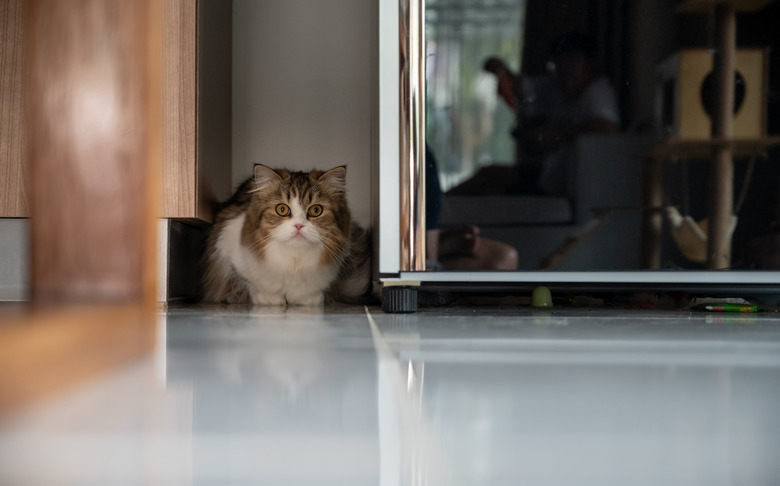Welcoming A Fearful Cat Into Your Home
Every pet owner wants their new pet to feel comfortable in their new home. What if you learn that your new cat is more fearful than other cats? You may never know exactly why a cat is fearful. They may not have been socialized properly. They could simply be a shy cat that needs extra time to blossom. Regardless of why a cat is fearful, there are correct ways to welcome them into your home.
All new cats need a safe place
All new cats need a safe place
Limiting new cats to the calmest room in your house, such as an un-used spare bedroom?) is a classic way to help them feel at home. This room is where you set up your cat's essentials: a litter box, food and water, scratching post and toys, as well bedding and a few hiding spots.
Giving your cat places to hide is important in the short and long term. Cats naturally like to tuck themselves away in safe spaces when feeling frightened or endangered. Covered beds, cardboard boxes, bundles of blankets — give your cat options! Just make sure the hiding places are accessible to you in an emergency.
Be sure to cat-proof your house by cleaning up anything harmful cats can eat or chew on, like toxic plants or electrical cables. And let your other family members or visitors know not to disturb anything in that room for a while.
Fearful cats need to feel even safer
Fearful cats need to feel even safer
Fearful cats feel extra vulnerable in new surroundings. It is easier on them if you have their safe room ready ahead of time. They need to be secured there as soon as possible. Scrambling around your house to clean and set up supplies will alarm an already scared cat. Take them inside while in their cat carrier, and allow them to explore their new environment on their own time.
When it comes to making a safe room or space for a fearful cat, consider creating a sheltered space inside of a larger room. When you're bringing home a shy cat, they may even find small rooms overwhelming. Consider keeping your new cats in a sectioned off corner or cat-proof closets where they can be out of sight. Your goal isn't to isolate or make your cat feel trapped. You're just giving them a safer-feeling space inside of a safe place!
Make the rest of the house feel safe
Make the rest of the house feel safe
Can your other family members commit to creating a calm and quiet environment? Loud noises and fast movements are common fear triggers in cats. An anxious cat will likely bolt or retreat when something scares them. Avoid constantly coming in and out of a fearful cat's safe room in hopes they will interact with you. This can not only spook them — it gives them opportunities to escape.
Also, you want the rest of your home to feel safe. Running appliances, playing music, watching television, loud houseguests — we know those things are harmless. Your fearful cat probably doesn't. Excessive noise won't convince them the rest of the house is safe. But you can help them during those early days by avoiding watching action movies, and limiting visitors. Your fearful cat is giving you permission to skip vacuuming for a few days. Once your cat settles into a routine you can work on desensitizing them by building positive associations with what scares them.
Adjusting a fearful cat will take some time
Adjusting a fearful cat will take some time
Prepare yourself for the possibility that it may take weeks, maybe months, before a scared cat is ready to leave their safe haven. If you're bringing home an adult cat, you don't know what experiences they had in their past homes that may make them scared or fearful. So take the time to adjust with them. Be patient and gentle with them, as they need to get to know you at their own pace. You can help them by keeping their life predictable, and comforting:
- Spend time in your cat's room, doing something laidback and nonthreatening. Maybe spend that time reading out loud on how to introduce your new friend to any resident cats or dogs? It should come as no surprise that also needs to be a slow process.
- Meal time needs to be at the same time everyday. Be around your cat while they eat, so your cat associates you with something wonderful.
- Give your cat fun things to do. A calm environment doesn't need to be boring. See if your new cat responds to a wiggling toy or tossed treat. Play with them with an interactive toy. This can take the edge of some of their anxiety — and teach them that you're fun to be around.
- Know how and when to touch your fearful cat. Don't pull your cat out of their hiding spots. Instead, watch your cat's body language. If your cat is puffed up, has flat ears, or enlarged pupils, then they are feeling anxious and need to be left alone.
In summary
In summary
You still need to decide if a fearful cat is the best fit for your household. Fearful cats need patient owners dedicated to giving them as much time as they need to adjust. Starting small, in a calm environment filled with pleasant activities, will make a fearful cat feel most welcome — and more likely to show off their whole personality.




